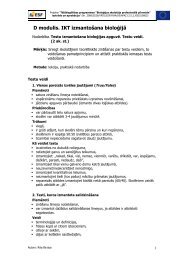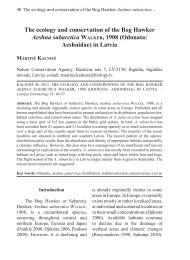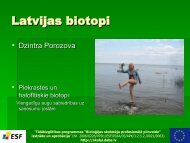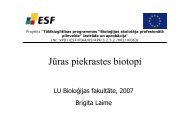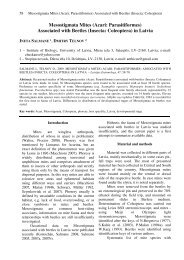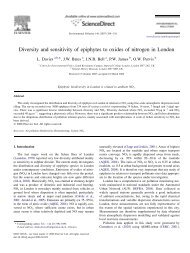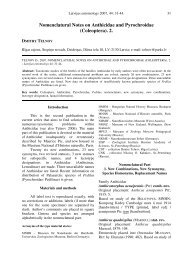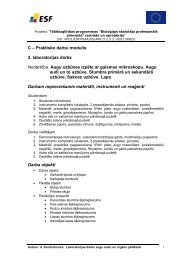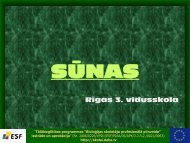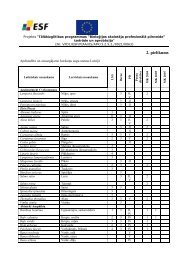Dissolved organic matter in water of Daugava river
Dissolved organic matter in water of Daugava river
Dissolved organic matter in water of Daugava river
You also want an ePaper? Increase the reach of your titles
YUMPU automatically turns print PDFs into web optimized ePapers that Google loves.
New ICT-dyes for Membrane StudiesO.Zhytniakivska* 1 , V.Trusova 1 , G.Gorbenko 1 , T.Deligeorgiev 2 , S.Kaloyanova 2 , N.Lesev 21 V.N. Karaz<strong>in</strong> Kharkiv National University, 4 Svobody Sq., Kharkiv, 61077, Ukra<strong>in</strong>e;2 Faculty <strong>of</strong> Pharmacy and Chemistry, University <strong>of</strong> S<strong>of</strong>ia, S<strong>of</strong>ia, Bulgariae-mail: olya_zhitniakivska@yahoo.comDur<strong>in</strong>g the past decades fluorophores which can undergo photo<strong>in</strong>duced <strong>in</strong>tramolecular chargetransfer (ICT dyes) f<strong>in</strong>d <strong>in</strong>creas<strong>in</strong>g application <strong>in</strong> biological sciences. Fluorophores whichexhibit ICT state are widely used <strong>in</strong> different areas, <strong>in</strong>clud<strong>in</strong>g the development <strong>of</strong> solar cellsand chemosens<strong>in</strong>g. High sensitivity <strong>of</strong> these compounds to the environmental polarityprovokes their use as fluorescent microenvironmental sensors, particularly, <strong>in</strong> the studies <strong>of</strong>membrane structure and prote<strong>in</strong>-lipid <strong>in</strong>teractions.The present study was undertaken to evaluate the sensitivity <strong>of</strong> newly synthesized ICT dyes,referred to here as ICT2, ICT4, ICT3 and ICT5, whose structures are given <strong>in</strong> Fig.1, to thechanges <strong>in</strong> physicochemical properties <strong>of</strong> lipid bilayer. At the first step <strong>of</strong> the study wecompared the lipophilic properties <strong>of</strong> the ICT-dyes and their sensitivity to the membraneenvironment. Fluorescence spectra <strong>of</strong> these dyes were recorded <strong>in</strong> buffer solution (5 mM Naphosphate,pH 7.4) and liposomal suspension. It appeared that only ICT2 and ICT4 arecapable <strong>of</strong> fluoresc<strong>in</strong>g, while ICT3 and ICT5 are non-fluorescent. ICT4 fluorescencedecreases, while emission maximum is shifted from 435 nm <strong>in</strong> buffer to about 420 nm on thedye transfer from the aqueous to lipid phase. On the contrary, the b<strong>in</strong>d<strong>in</strong>g <strong>of</strong> ICT2 to themodel membranes was followed by the fluorescence <strong>in</strong>crease without any shift <strong>of</strong> theemission maximum. Moreover, fluorescence quantum yield <strong>of</strong> ICT2 exhibited tenfold<strong>in</strong>crease <strong>in</strong> the lipid bilayer compared to the buffer solution, while that <strong>of</strong> ICT4 decreasedabout twice.H 3 COCH 3 SO 4ISNCH 3SNCH 3NNCH 3CH 3OACHS3NNCH 3(CH 2 ) 3 NH 2 HBrCDFig. 1. Structure <strong>of</strong> the dyes ICT2 (A), ICT4 (B), ICT3(C) and ICT5 (D)To characterize ICT2-lipid b<strong>in</strong>d<strong>in</strong>g quantitatively, at the next step <strong>of</strong> the study we determ<strong>in</strong>edthe dye partition coefficient KPfor different lipid systems. The values <strong>of</strong> KPwere found t<strong>of</strong>all <strong>in</strong> the range (0.4 – 1.5)×10 4 <strong>in</strong>dicat<strong>in</strong>g that the exam<strong>in</strong>ed dyes possess high lipidassociat<strong>in</strong>gability. Analysis <strong>of</strong> the partition coefficients shows that <strong>in</strong>clusion <strong>of</strong> anioniccardiolip<strong>in</strong> and cholesterol <strong>in</strong>to phosphatidylchol<strong>in</strong>e bilayer gives rise to the <strong>in</strong>crease <strong>of</strong>partition coefficient relative to the neat phosphatidylchol<strong>in</strong>e membrane.To summarize, a comparison <strong>of</strong> the fluorescence properties <strong>of</strong> the four newly synthesized ICTcompounds revealed that despite be<strong>in</strong>g structurally similar, these dyes display differentspectral and lipid-associat<strong>in</strong>g behavior. ICT2 was featured by the most effective partition<strong>in</strong>g<strong>in</strong>to lipid phase coupled with considerable <strong>in</strong>crease <strong>of</strong> the fluorescence quantum yield. Therecovered properties <strong>of</strong> ICT2 allowed us to recommend this dye for further use <strong>in</strong> membranestudies. This work was supported by the grant from Fundamental Research State Fund <strong>of</strong>Ukra<strong>in</strong>e (project number F.41.4/014).ISNCH 3 SO 4CH 3OCH 3B- 36 -



